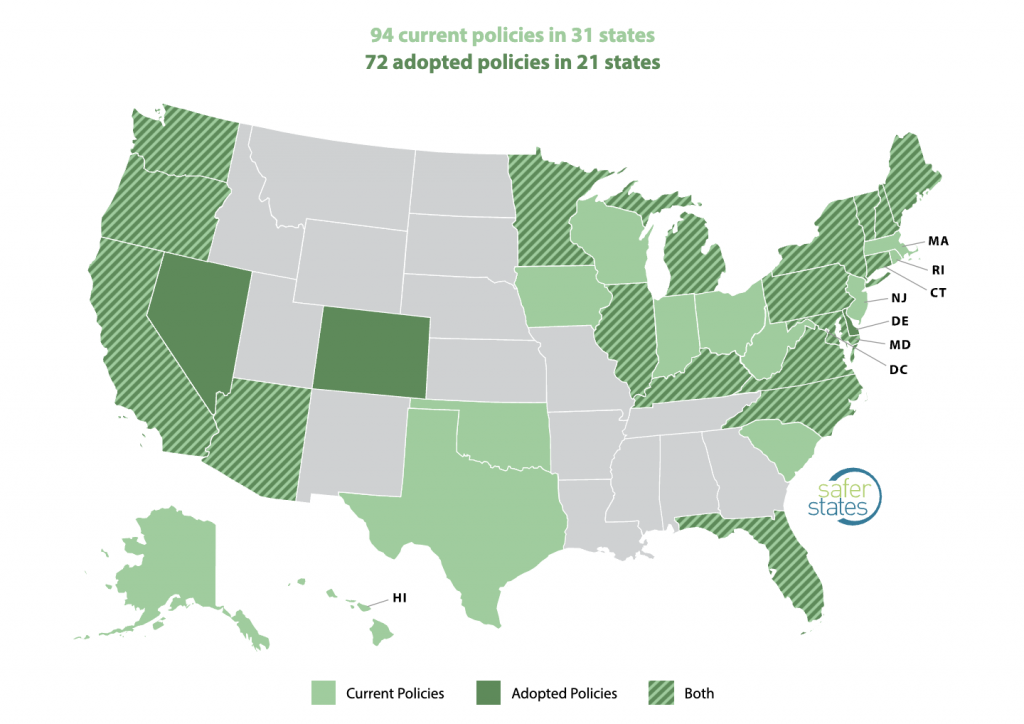Finding Inspiration Beyond Your Project Boundary
After more than a decade working as a sustainability consultant specializing in materials, Lisa Carey Moore joined ILFI in August 2021 as its Manager, Products and Materials. In her first article for Trim Tab, she shares some recent sources of inspiration, and the reflection they caused, with the hope that it will provide you with the spark to recommit to your essential work around materials.

The Living Building Challenge’s Materials Petal is often cited as being the most daunting of the Living Building Petals, but the work done to achieve it is impactful far beyond the project’s boundary. Every product specified has a bearing on environmental, human health and community well-being. Each conversation with an ingredient supplier, every search for alternate solutions with subcontractors, and adjustments made to an interior palette have reverberations within the wider movement of practitioners, advocacy organizations, and policymakers who are working to create better products.
As someone who has spent considerable time over the last decade collaborating with manufacturers and project teams to find optimized materials (optimized by chemistry, emissions, responsible sourcing, and embodied carbon) for Living Building Challenge projects, it has been important to me to connect with other sectors to understand the work they’re doing to make a difference. At the very least, I learn new things, and at best, I recognize how my work can contribute to better outcomes. This insight fuels me to carry on.
It’s About Much More Than Cosmetics
In early October of 2021, a comprehensive safer beauty bill package was released to the U.S. House of Representatives. There are many aspects of each bill that are important, but the one that might be of particular interest to our Architecture, Engineering and Construction (AEC) community is The Cosmetic Supply Chain Transparency Act of 2021. Why? It is the first piece of U.S. federal legislation around chemicals in products to codify the requirement for transparency in the supply chain, while leveraging financial penalties on up-stream suppliers if they don’t provide this information. According to supporters, if passed, the legislation will mandate that suppliers provide brand owners with ingredients, toxicity information, safety data, and certificates of analysis allowing brand owners access to information they need to make safer beauty and personal care products. This bill was created by a broad coalition of beauty product manufacturers and non-government organizations (NGO), and at a moment when supply chain challenges have become salient, some supporters are optimistic that it will find fertile ground in the U.S. Congress. For those working within ILFI’s programs, you’ll recognize that transparency, one of our guiding principles, is at the heart of this bill’s power. Even though it will have a long journey to become law, it already serves as an important example of national interest in supply chain transparency to achieve reduced toxicity—an example that both project teams and manufacturers can point to. Since supply chains for cosmetics and personal care products are global, this could provide leverage to AEC practitioners worldwide in their work with manufacturers to get transparency, and could help manufacturers working to get ingredient information from their supply chains, as well.
It’s a Time When Regulators Are Stepping Up
Pivoting to the European Union (EU) for inspiration, I’ve heard from those working on specifying and making products in the EU member states that polyfluoroalkyl substances, or PFAS, have been in the news a lot. One point of discussion is the Chemicals Strategy for Sustainability, adopted by the EU on 14 October 2020, as part of The European Green Deal. This framework offers provisions to restrict chemicals that exhibit any chronic toxicity (carcinogenic, mutagenic, or toxic to reproduction), including substances which are persistent, bio-accumulative, and toxic in consumer products, unless the use is essential. For instance, PFAS materials used in medical devices might be categorized as essential, whereas their use as a non-stick cooking surface might not be. The word “essential” is now at the crux of debates well beyond the EU.
Already, there are advocates in the U.S. who are growing wary of this term. Rather than essential, they think we need to focus on products where we know we can completely avoid PFAS, first, and then figure out how to address the use of these chemicals in product types where it’s “currently unavoidable” due to technological limitations. As Sarah Doll, National Director of Safer States explained to me recently, semantics are important, as currently unavoidable acknowledges a time bound limitation. Since there’s strong scientific evidence that we need to eliminate the flow of PFAS into the environment, it’s important to keep the focus on moving toward healthier chemical alternatives. ChemSec (the International Chemical Secretariat) is an independent NGO that advocates for the transition from toxic chemicals to safer alternatives, and they note that since launching their PFAS Movement in 2020, there are already fifty companies who have joined the initiative, and already 46% say that they have eliminated PFAS in all products.
As the publication of the Green Science Policy Institute’s report on PFAS in building products, Building a Better World: Eliminating Unnecessary PFAS in Building Materials, highlighted earlier this year, the challenges posed by the PFAS class of chemicals fall squarely in the AEC realm, as this family of chemicals is ubiquitous in everything from roofing materials, to paints and coatings, and used components in our energy and water systems. A draft report from ChemSec that should be released by year’s end shows similar findings. While unsettling, the timing of these reports couldn’t be better, as significant action around PFAS is happening globally. For instance, back in the U.S., the state of Maine has passed some of the most comprehensive legislation found anywhere. The law regulates PFAS in all products, prohibits the sale of new items containing intentionally added PFAS beginning in 2023 (starting with carpets, rugs and fabric treatments), and requires ingredient data from manufacturers to be submitted to a central registry so that future product types can be added. In addition to Maine, there are dozens of states who have passed, or are considering legislation around this chemical class, and in a variety of ways. Notably, Michigan took the interesting approach of tackling the problem via procurement, with a state directive that mandates their agencies give preference to suppliers who offer products that are PFAS free. As states continue to pass legislation regulating this class, U.S. and global manufacturers who provide products to these markets will need to take notice. This, coupled with increased scrutiny of the chemical class by other countries around the world, should help project teams as they work to avoid PFAS in building materials. In ILFI’s ecosystem, our Declare manufacturers received correspondence from us about this class in February 2021 when ILFI added 4,870 chemical abstract numbers—essentially the entire class of PFAS and Perfluorinated compounds (PFCs) chemicals—to its Priority Watch List. ILFI is currently engaged with a volunteer group of outside experts to help with the next iteration of the Red List due out in January of 2022 to ensure it reflects best practices in chemical management.

It’s a Time to Celebrate, and Reflect
The final source of inspiration I want to share is courtesy of the Burwood Brickworks project, a retail center owned by Fraser’s Property in Wurundjeri Country, Burwood East, VIC, Australia that achieved LBC Petal certification (Place, Health & Happiness, Materials, and Beauty Petals) in spring of 2021. To magnify the impact of their materials work on the largest LBC certified project in Australia to date, the project team virtually launched their Greensheet tool in September 2021, billing it as “Australia’s first full publicly-shared list of building materials.” Their materials effort was led by Stephen Choi, whose team of researchers collaborated with 40 tenants to identify and select products for a diverse variety of businesses including restaurants, a medical center, cinema and a supermarket. As the project’s promotional materials note, “More was asked of retailers at Burwood Brickworks than retail tenants had ever been asked before.” As I watched the launch, I thought, “Hooray for the tenants who made the commitment!” and “Good for the owner to bring them all on board!” The Greensheet currently lists more than 1,400 building materials used on the project, and it will be updated as new products are added to the project in the future. An important element of the tool is that it is transparent about the fact that LBC projects may contain products that are sub-optimal because the Materials Petal goals are aspirational, and the market can’t yet deliver. This is useful, as it helps other project teams and manufacturers realize ILFI’s approach is not “all or nothing.” Understanding the products and product categories where Red List chemicals are still used highlights areas for research, development and product innovation to find better alternatives.
Altogether, Burwood Brickworks has provided a fantastic example of how our LBC projects keep on “living” by spurring critical market transformation beyond the project’s completion, and well beyond the site boundary. Sharing our experiences can benefit project teams, as well as those advocating for better policies for safer products, transparency requirements, or even for new codes around energy and water technologies. So, as I start my journey at ILFI, here’s to thinking about how we can share our successes, as well as the lessons we learn, in meaningful ways, and to being open to inspiration outside of the typical work we do.
If you have ideas and stories to share around materials, please reach out to Lisa if you have ideas and stories to share around materials at lisa.careymoore@living-future.org.



